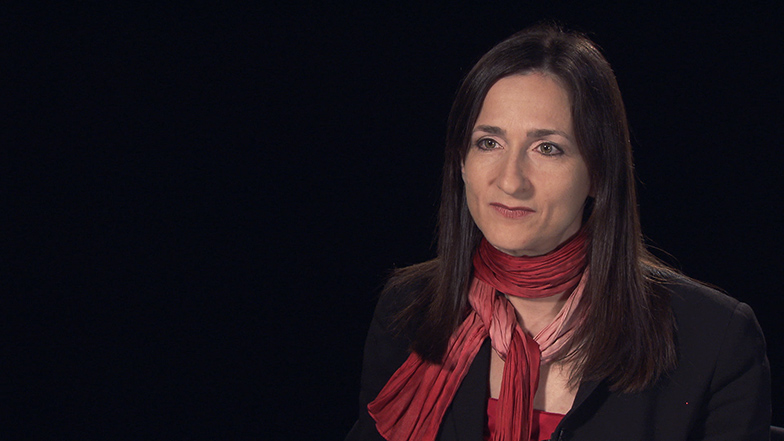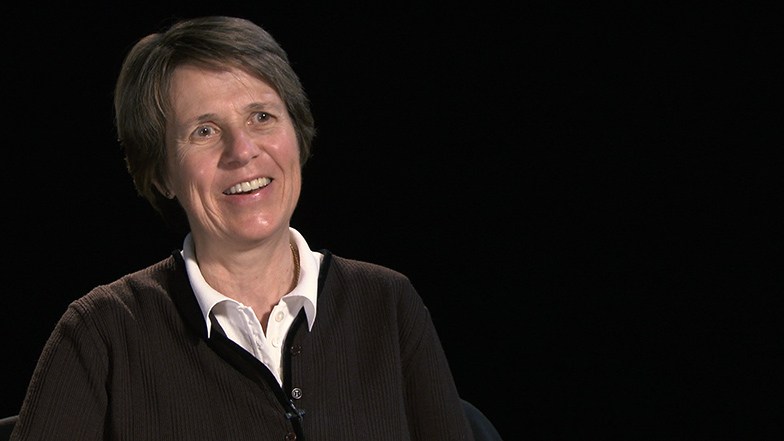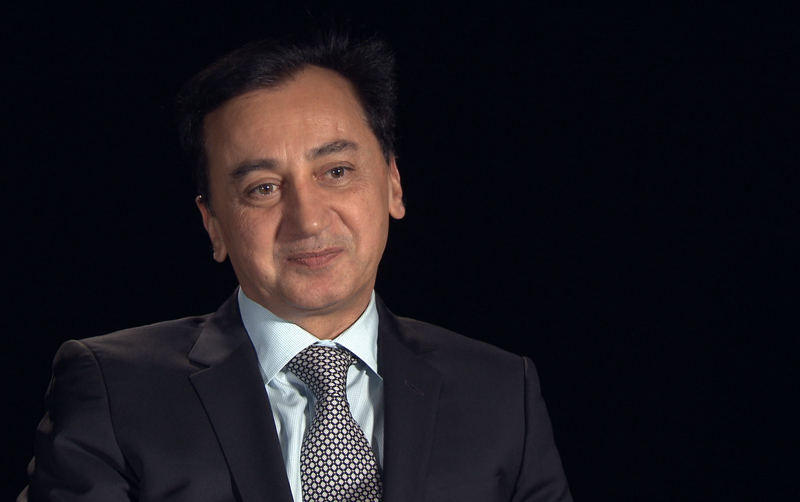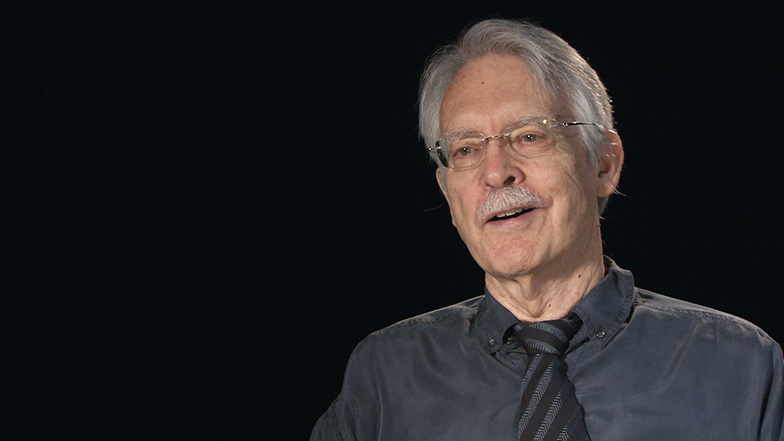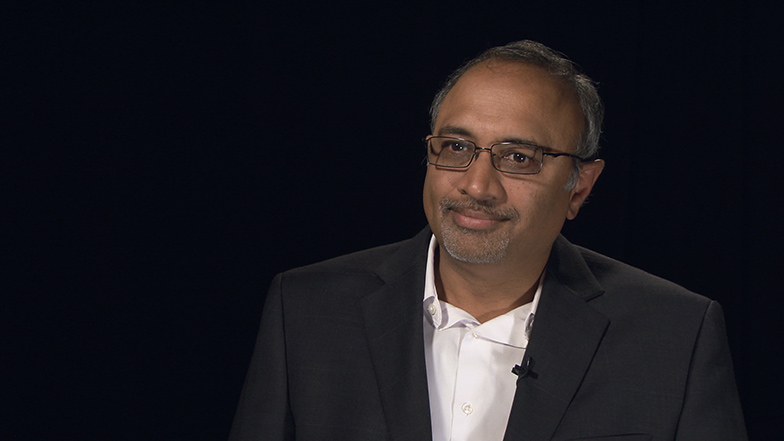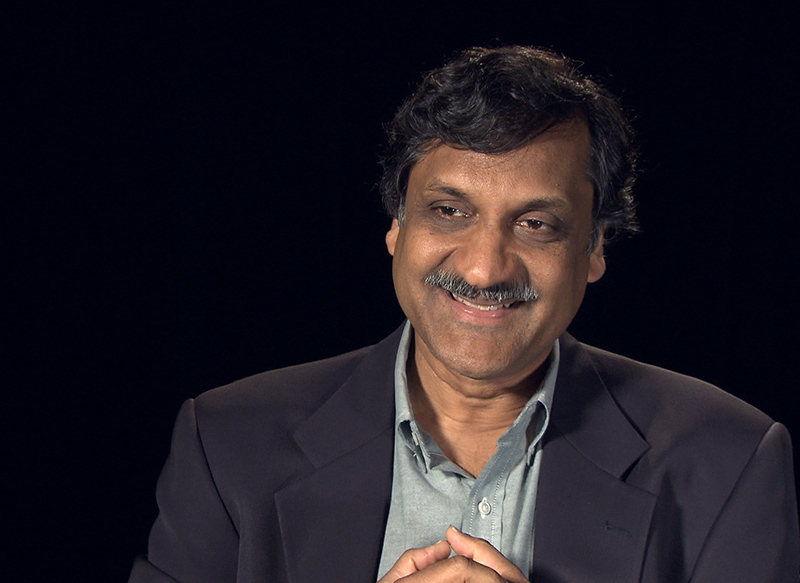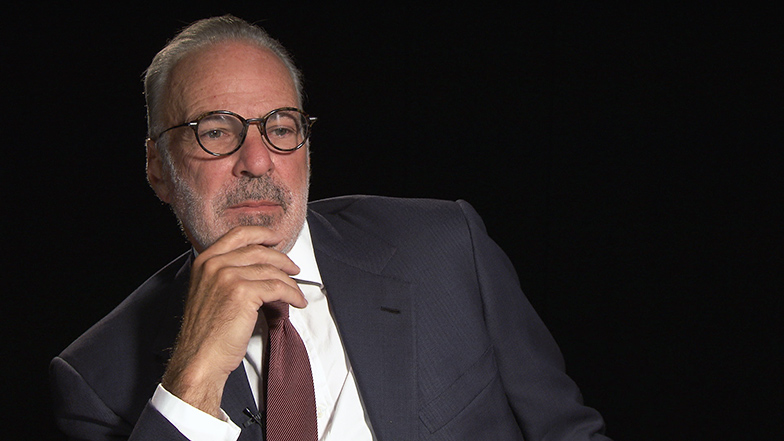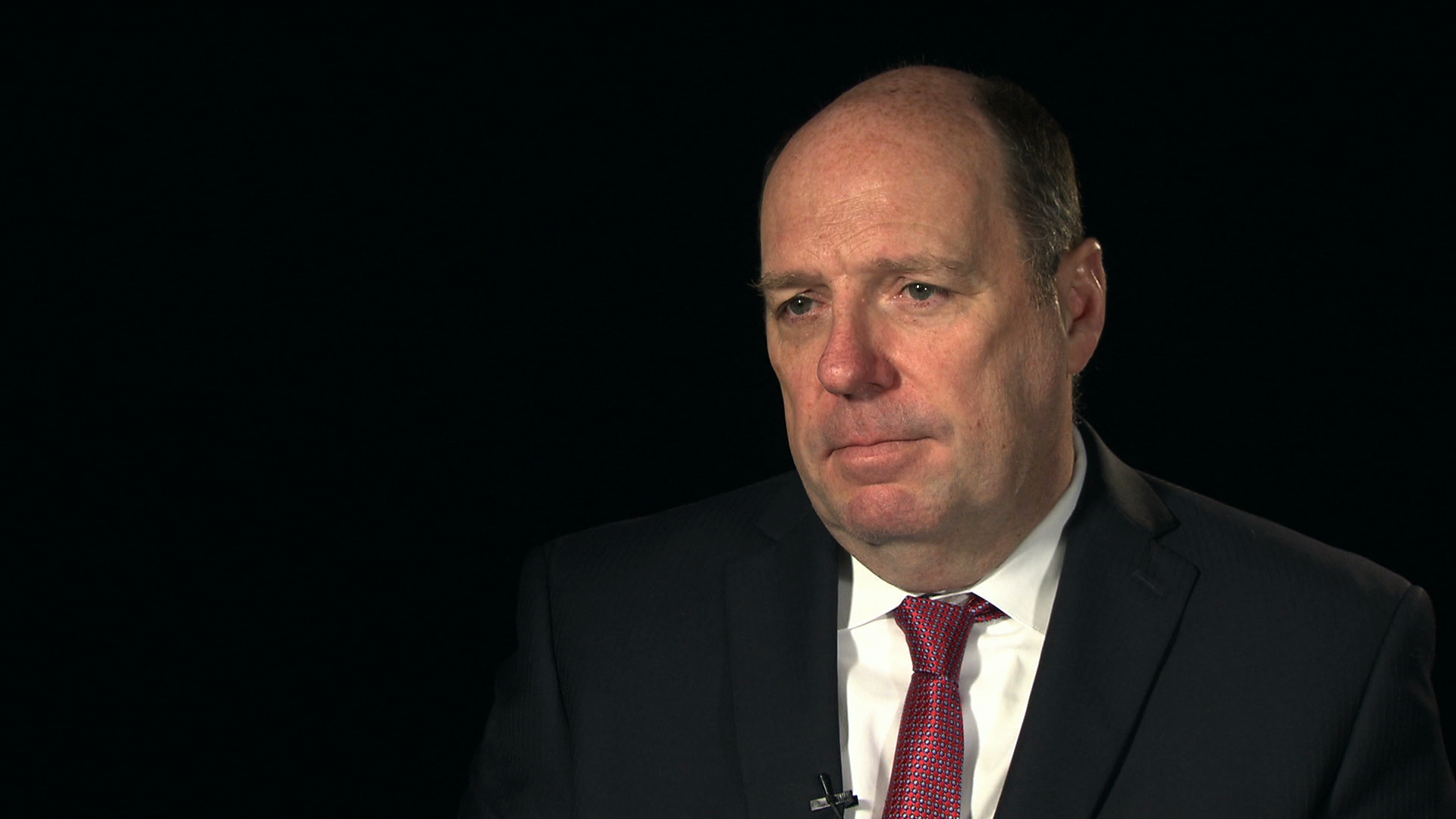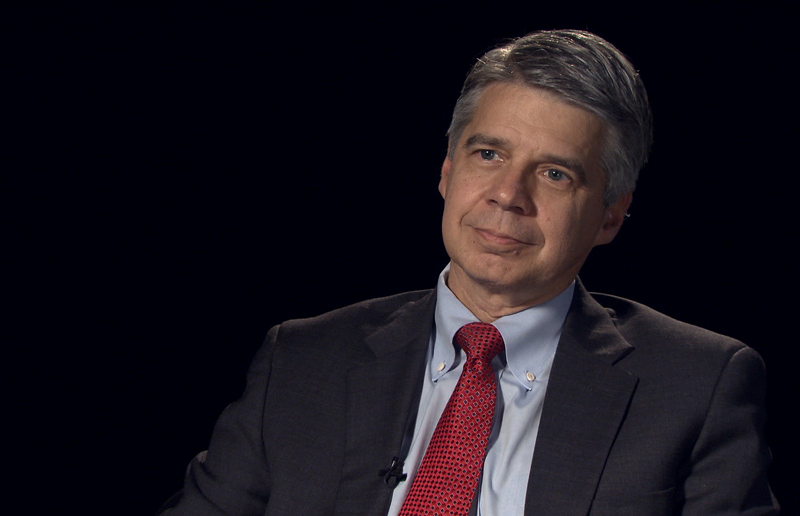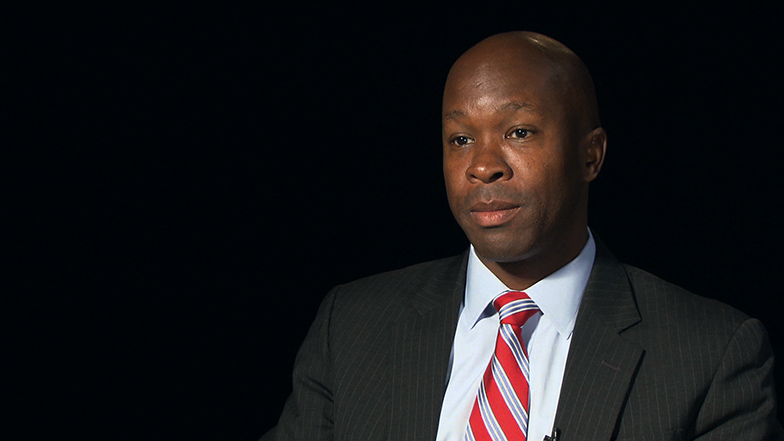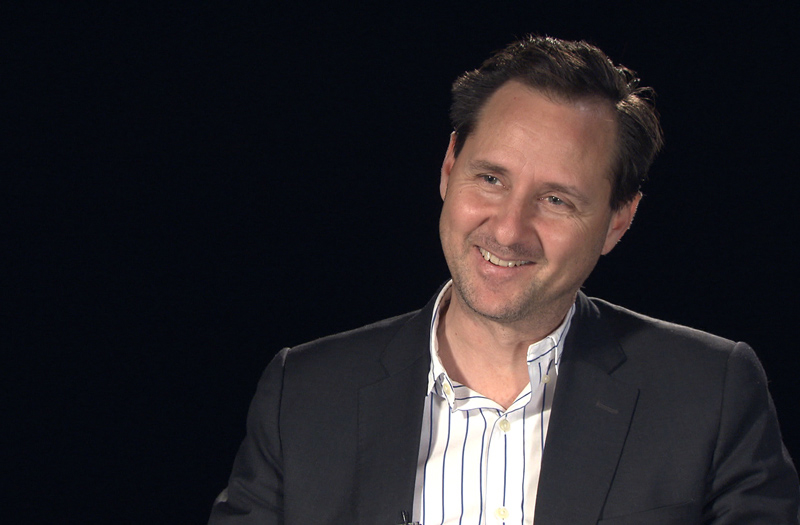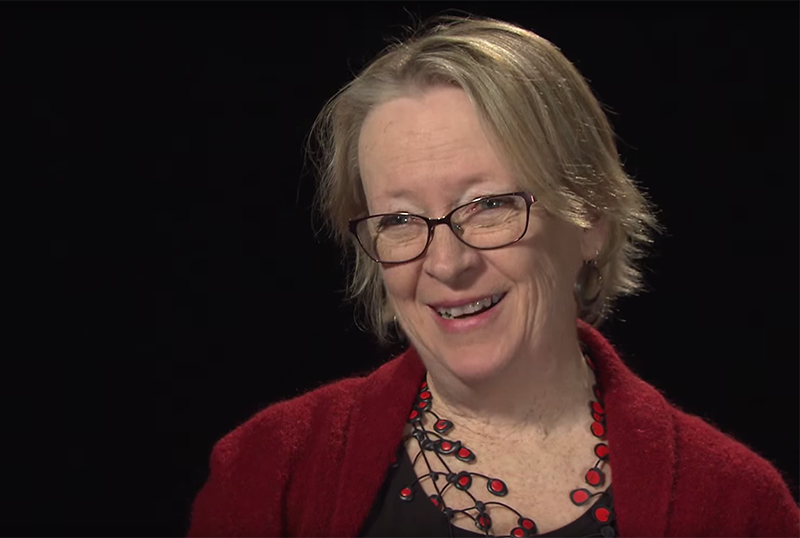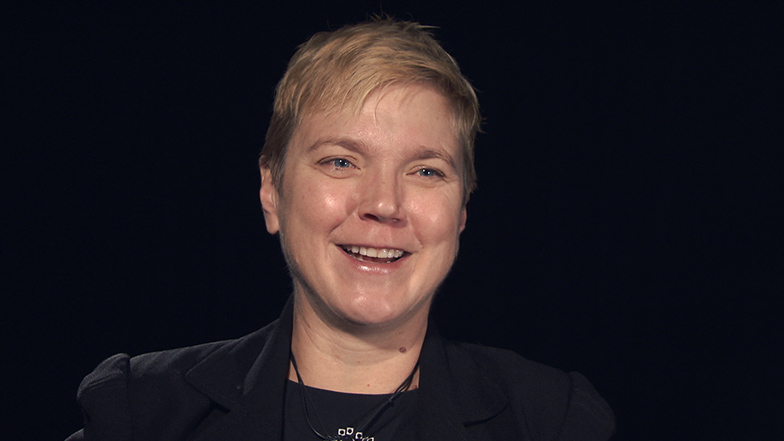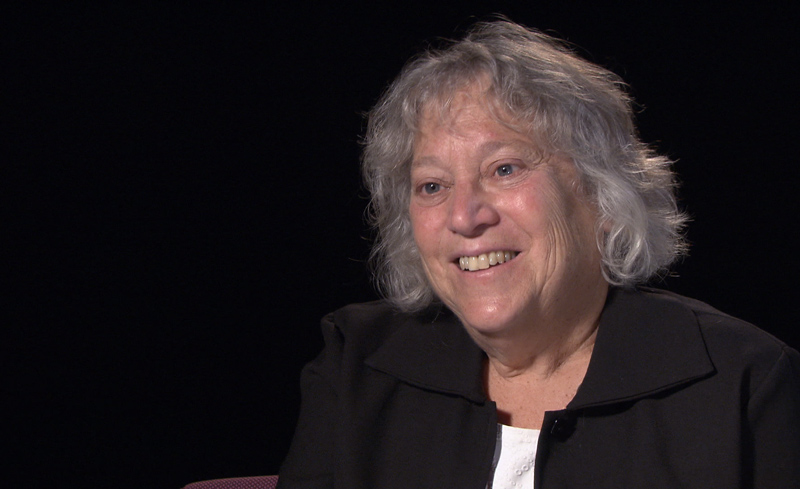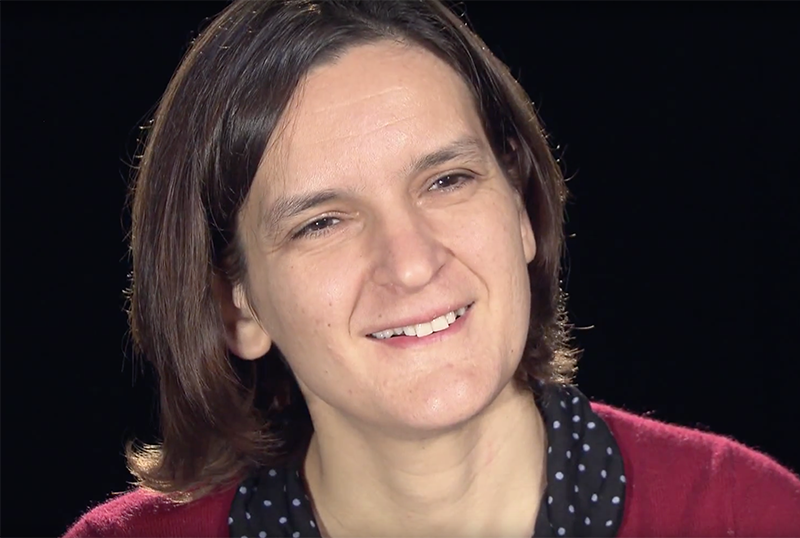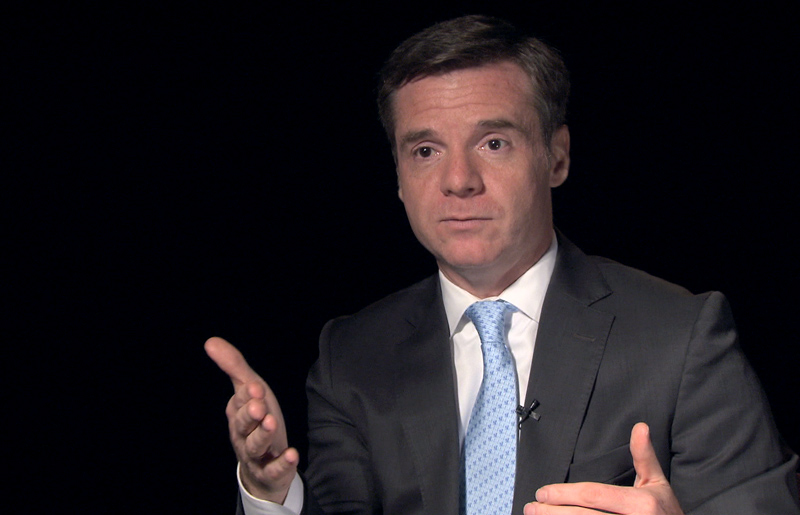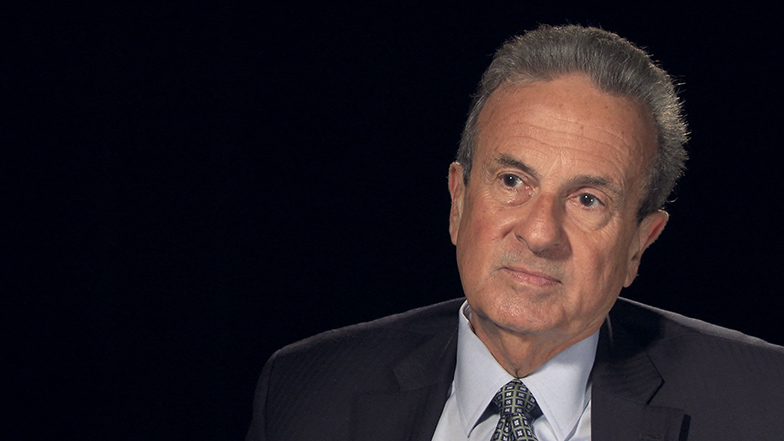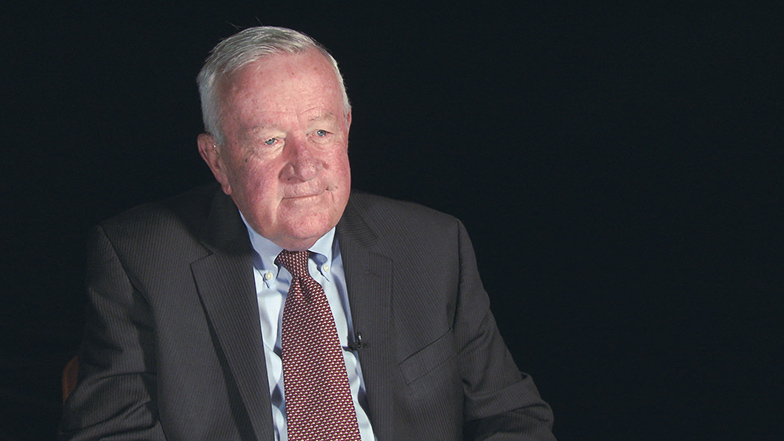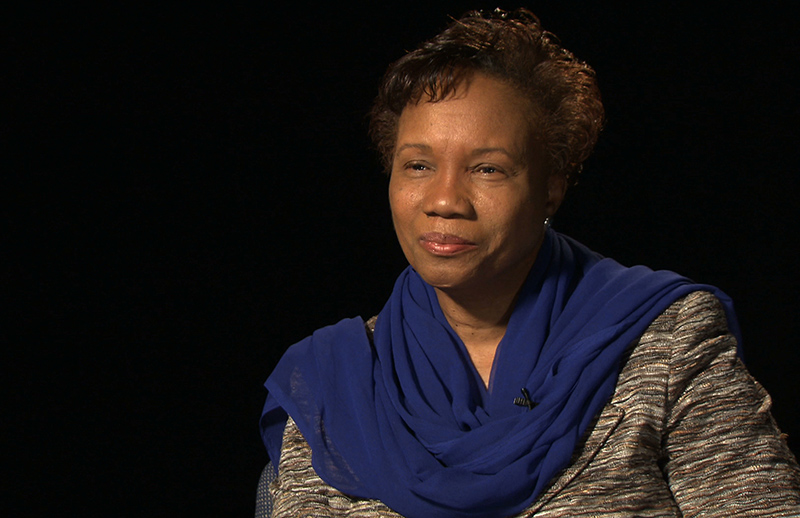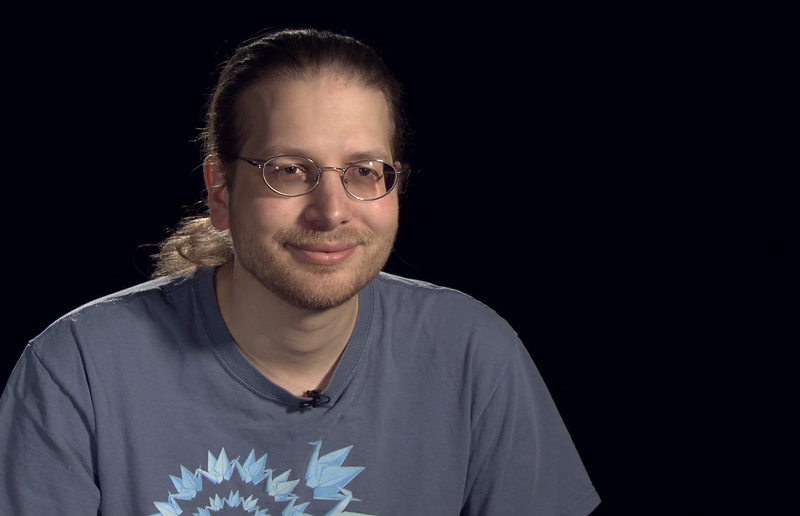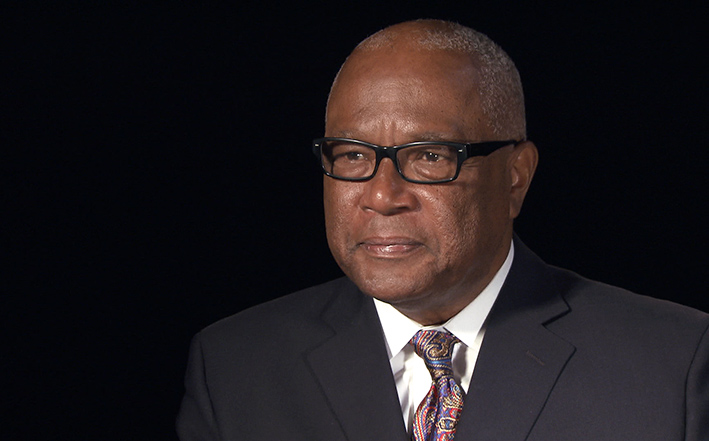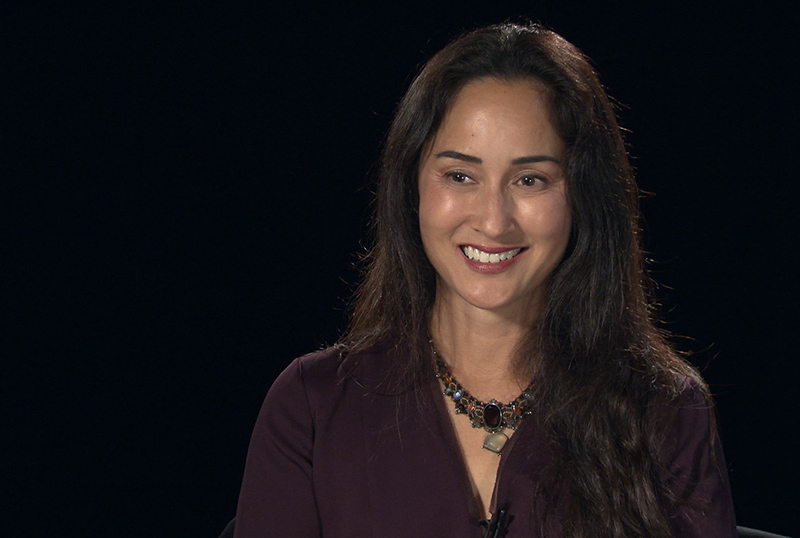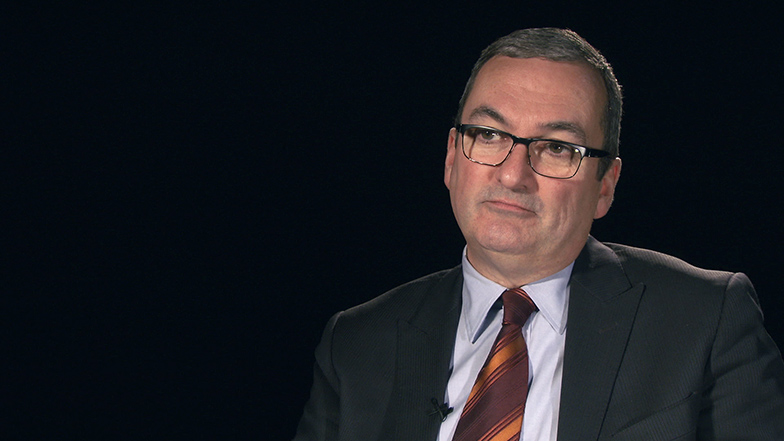Sara Seager
INTERVIEWER: Today as part of MIT's Infinite History project we're talking with professor Sara Seager, the MIT Class of 1941 Professor of Planetary Science and Physics. Professor Seager, you joined the MIT faculty in 2007 to lead MIT's efforts in the emerging subfield of exoplanet exploration and characterization-- exoplanets being planets circling stars other than our sun. Prior to MIT, you spent several years as senior research staff member at the Carnegie Institute of Washington, and before that, at the Institute for Advanced Study at Princeton.
You're pioneering research on the theory of computation and data analysis of exoplanets and innovative work on space instrumentation are opening new celestial frontiers and fueling essential questions about life beyond Earth. In fact, your research goal is to find another Earth-like planet with signs of life. Sara thank you for taking time to speak with us today.
SEAGER: Thanks for including me.
INTERVIEWER: Happy to. And so we'll start on your early years and influences. Growing up and what experiences got you excited about the work you do, or just excited?
SEAGER: Sometimes, it's hard to trace back what happened in childhood to lead to today. But in my case, when I look back, there were a few distinct events that still remain so strong in my mind. One of them-- when I was a small child, my parents were divorced, and my dad would drive me from the downtown city I lived in out to the suburbs where he lived every week so I could spend the weekends with him.
INTERVIEWER: This was in Canada?
SEAGER: In Canada, in Toronto, Canada. And I just remember the moon following me. And that means that no matter how far we went or how often we turned or which direction we went, the moon was always there. I just couldn't understand why it was always following me. And I'd probably ask my dad-- I guess he didn't have the right answer, because I was always puzzled about it.
INTERVIEWER: He wasn't a scientist?
SEAGER: He wasn't, actually. He was trained as a medical doctor, but I'm not sure. You know when kids are constantly asking questions? Maybe he didn't feel like answering. Maybe he didn't know the answer. But I just now know the answer, actually. The answer is the moon is just so far away, it just appears fixed in its direction and position. And so I just always like watching the moon.
When I was about five years old, my dad took me to a star party. That's where astronomers get together with telescopes, and they usually welcome the public to come and view through their telescopes. And I remember seeing the moon for the first time. Have you ever seen the moon through a telescope?
INTERVIEWER: A low res one.
SEAGER: You must see it, because it is absolutely spectacular. And I did a [GASPS]. I just had never imagined that there was so much detail. The moon, that object in the sky that had been following me, it was so detailed with craters and dark and bright patches. And it was just astonishing. Like any kid, I would have forgotten about that and not really thought about it again.
And now fast forward to another memory when I must've been about 10 years old. And my dad figures prominently in a lot of these memories. In this particular case, it was his first and last camping trip. We had a babysitter for the summer who decided to take all of us on a camping trip. And I remember waking up in the middle of the night from my tent, walking outside, looking up at the sky, and wow.
There were just so many stars. I was so overwhelmed. I think my heart skipped a beat, figuratively speaking. I just couldn't believe it, again. Wow. No one ever told me this. I just hadn't known about it. Who would have known there were just so many stars out there? And I think memories like that kind of stayed with me.
Although I wasn't-- I was going to say wasn't a nerdy kid, but I wasn't the type of kid who would do experiments or go ahead in physics or do anything in detail academically extracurricularly. But I definitely remember strongly these things in astronomy from my childhood.
INTERVIEWER: It makes me think of inner city kids who don't even know there are stars up there sometimes.
SEAGER: Right. Well, I knew there were stars. And fortunately, in my hometown, there was a planetarium. It's no longer open, unfortunately, but we could see the stars in the planetarium.
INTERVIEWER: You're described yourself as a daydreamer, a risk taker, a born explorer. Can you remember experiences that shaped your temperament?
SEAGER: Well, some of them are somewhat mundane. But school was very boring for me. Most time in elementary school or even through high school, I just honestly had so much time to do nothing at school. And my dad often referred to school as free daycare. So I just remember having a lot of time to think about stuff. And I don't have very specific memories, but just having a lot of time to think creatively about random things.
And just for example, one time-- I grew up in a very old house in the inner city in Toronto, Ontario, Canada. I just remember even things like the molding on my ceiling. We had this-- for whatever reason, very intricately detailed-- but a big molding where, for whatever reason, a chandelier in my room hung down. And just things like that-- it was randomly, haphazardly put together. It certainly wasn't like a well off downtown area. But just staring at those things for a long time, looking at the patterns, and just letting my mind go.
INTERVIEWER: And then how did you discover astronomy per se as a passion?
SEAGER: Well, later on, actually, when I was in high school, I did take an astronomy class at my local planetarium. And I was so excited. It was probably my favorite class ever. The-- what we call bit rate was really low, but I could sit there and still enjoy it. And we got to learn about the constellations right in the planetarium itself.
It would have been an amateur astronomer teaching, not a professional astronomer or anyone. But what I didn't-- because I lived in the inner city, I knew about the University of Toronto, and I had seen signs outdoors for an open house. And so I went. I must've purposely gone to the astronomy open house.
But all I remember was seeing a table with pamphlets and professors talking and they had grad students showing the telescopes that weren't used for research, but for education. And I arrived at this open house, and it was another aha moment. I was like, wow, you can be an astronomer for a job? I just couldn't believe how great that was. It had never occurred to me you could have a job that was intriguing and just appealing at some level.
And at that time, I went home. It was the weekend, so I went home and told my dad-- I think I was about 16 or 17 years old. I was like, I can't believe I can be an astronomer for a job. This is so exciting. And from my father, I got an absolute no. And I got a long, hard lecture of him telling me I had to be able to get a job to support myself and not rely on any man. And he didn't know what astronomers do or what physicists do. He just assumed that unless it was a job that he knew about where you could be employed and employable, that it wasn't a good idea.
INTERVIEWER: So what did you do?
SEAGER: Well, the thing is, when I went to university--
INTERVIEWER: Which was where?
SEAGER: When I went to university, which was the University of Toronto, I did take all the science classes in my first year since I didn't know what my job would be. I kind of wanted to go into physics. I had this naive concept that one could write an equation down to describe every natural phenomenon.
INTERVIEWER: So you were good at math already?
SEAGER: Right, I was good at math, but I wasn't spectacularly good. The people who are mathematicians today, they had a facility with math the way some people can pick up any language. I know that, because one of my kids is like that. But the way they perceive patterns and understand abstract concepts, I wasn't that type of math, but I was good at math.
And I went into university, and I took all the classes. My dad wanted me to be a doctor, so I made sure I covered all the pre-med. And I thought that physics was going to be-- it was actually very exciting, but it was ultimately crushingly disappointing.
Because the first thing you learn is how to make approximations. You write down an equation, and you have to figure out which terms matter and which don't, and you throw out the terms that don't matter just so you can make progress in solving the equation and making it applicable to some real phenomenon in the real world. So I was a little disappointed by the rampant approximations in physics.
But I did go through university. I was able to get a summer job at the local observatory run by the university called the David Dunlap Observatory. It's no longer part of the university. And I had a summer job there working on variable star astronomy.
And I think it's really important to be welcomed into the fold in whatever way. And my professor was really great to me.
INTERVIEWER: And you felt ready to go straight on to grad school in that area?
SEAGER: Well, it turns out that some people, if you ask them about how they got where they are, they had a definite plan. They're going to go to MIT, and then they're going to grad school, and they're going to do this and that. I never really had that in my mind.
INTERVIEWER: Well, pre-med, perhaps, even?
SEAGER: Pre-med, but I only knew what my dad knew. And I didn't know about, really, grad school until I entered university and I saw older students who were graduate students. So when I got along to third or fourth year, I realized that-- I don't know how I knew this, but somehow, deep inside of me, I knew that I was so lucky to have something I loved doing, that I was good at, and that I may as well pursue astronomy.
INTERVIEWER: And so you were at Harvard as a grad student?
SEAGER: Right. So I applied to graduate schools, and I went to Harvard. And that was my first time away from home, really. I was 22, 23 years old, and I moved here. I remember it quite clearly. My sister drove out with me, and she attended all the graduate orientation, and then she left. She did the fun part, and there was left all alone.
INTERVIEWER: Well, you eventually worked with your research supervisor. Maybe you can pronounce his name better. And interested about this frontier breaking project that he had given you. Could you just talk about that?
SEAGER: Well, my first project, actually, was in cosmology. And my research advisor-- his name is Dimitar Sasselov. I was his first graduate student. But I worked on the problem in cosmology, which turned out to be a really important one, actually. And only recently did my exoplanet-- my highest cited paper in exoplanets only recently superceded the number of citations I have on my cosmology paper.
So I did a cosmology paper. It was a master's level project. And when I was finished with that, the question is what next? Well, I could continue in that same area of cosmology, but it was pretty clear it was going to dead end. There wasn't a whole fertile future in that area.
INTERVIEWER: What was that paper, by the way, just generally?
SEAGER: Well, the paper is called Recombination in the Early Universe, or how exactly did the universe become neutral. And what happened is that after the Big Bang, everything was hot. There are protons and electrons floating around. But as things cooled, those were able to form hydrogen and helium and a bit of lithium. But the universe was expanding more quickly than all these protons and electrons could find each other. So there's a residual electron fraction left over.
Now, today, we measure things about the Big Bang based on the cosmic microwave background radiation, a 3-degree Kelvin radiation that pervades all around us. But that radiation is not smooth. It holds memory, actually, from the so-called last scattering surface. And that means that as the photons are streaming all around and bang into things, actually, there's this last scattering surface.
Imagine a screen of fog, but in this case, it's just electrons. And how many of those are as a function of time really matters to that pattern that gets imprinted that we observe today as temperature and isotropy on the sky in the microwave background.
Well, it was my calculation that was the first modern computer calculation of a problem that had been worked on in the 1960s. It had never been revisited by modern calculation until I did it in the 1990s. And I actually did find a tiny-- remember, we're talking about approximations-- an approximation they had made, which was totally fine for the precision required for all those decades, but now with the new measurements, wasn't actually perfect.
So I found, actually, an inconsistency. What they approximated shouldn't have been an approximation. I could go into more detail if you wanted, but it gets a bit technical. And that actually gave us the precise electron fraction as the function of time.
And so everyone who worked on the cosmic microwave background and used the code that I had written, they actually had to cite that paper. So that got a lot of citations.
INTERVIEWER: Is that a big deal as a master's level to have that?
SEAGER: It is. And that's, I think, part of the currency in academia, is just doing something important that is useful. But I have to tell you that in science, a lot of luck is involved. There's cleverness and luck. But what if my adviser had chosen for me a project that didn't go anywhere? That instead of me finding, oh, they made this approximation that they shouldn't have, what if nature favored the approximation, and actually it was OK after all? I would have just verified what they did after two years of work.
INTERVIEWER: So you're right. It's both things.
SEAGER: So after the cosmology project, I was looking for a new project.
INTERVIEWER: For your thesis?
SEAGER: For my PhD thesis. And to be strategic, one doesn't want to start completely from scratch. And my advisor, Dimitar Sasselov, had some interest in the new exoplanets that had just been discovered months earlier. And these planets-- we call them hot Jupiters. They're Jupiter-sized or Jupiter mass planets. Well, they're Jupiter mass planets orbiting so close to the star, many times closer to their star than Mercury is to our son. And so they're heated up tremendously. We knew nothing like this, actually, before these planets were discovered.
And it turned out that a lot of the computer code I had written for the cosmology project, I could build upon that for the Exoplanet Atmosphere project, because radiative processes are radiative processes, just the planets are more dense and much colder. Actually, they're a lot more complicated than the early universe.
INTERVIEWER: And they're not always Jupiter's mass, the exoplanets, but those are the ones that people are looking at first?
SEAGER: Right. At the time, we only had a handful of planets that were known, and these were big planets close to the star, because those were the only ones that people could find initially.
INTERVIEWER: So again, why was it risky? I gather it's new, the exoplanets were new.
SEAGER: Well, the reason it was risky-- it seems kind of silly now, but at the time, everyone expected that our solar system was the norm, and that we should find, if anything, copies or things very similar to our solar system. Now, our Jupiter is five times the Earth-Sun distance, five astronomical units. These hot Jupiters are 0.05 astronomical units. They're 100 times closer to their star than Jupiter is to our sun. In other words, no prediction of these, no knowledge, no way to comprehend that a planet like that could either form so close to the star, or how it got there was just a huge mystery.
And it's true in science we like Occam's razor. We want the simplest explanation. There's no need to invoke anything that's just crazy. Why? And so in science also, it's really our job as scientists to push back so science gets validated. And so many astronomers and many scientists didn't believe they were planets. They thought a simpler explanation would be that the star was pulsating or there's changes going on in the star instead of an unseen planet orbiting the star. And it took a few years for this debate to play out.
INTERVIEWER: So was he taking the risk advising you, or were you taking the risk going ahead?
SEAGER: I think we were probably both taking a risk. In some sense, he might have known it was less of a risk than I did, because he and one of his colleagues at Harvard, they had no doubt that they were really planets. But on the other hand, people were constantly coming up to me-- even other professors at Harvard-- just not believing.
Other students in other institutions would say, oh, you can talk to my advisor, but this project shouldn't be done. Or people on my thesis committee would say, well, OK, I finally do believe they're planets, but we're never going to study their atmospheres. Why would you even bother working on this?
INTERVIEWER: So why did you bother? What gave you the courage?
SEAGER: Well, I have to have to have a better answer than I don't really now. I think it just was my nature to do something new and interesting.
INTERVIEWER: That didn't unnerve you to have all this--
SEAGER: The reason it didn't unnerve me-- believe it or not, one of the reasons was I wasn't actually committed to a career in science. And so I actually had nothing to lose, really. That was one reason. Another reason was you have to understand that in theory, working on a project is almost never a waste of time, because I was still learning.
And what I was working on was a computer code to understand how radiation from the star interacted, heated with, and anything else to the planet atmosphere. And there are other objects that are close together in astrophysics. Even though the regime may be quite different in terms of temperature and pressure, I knew that I could at least have the skill set to apply to another area of astronomy.
Or the other thing, as most people are told over and over again-- at least we were in school-- that in the physical sciences, a Bachelor's degree or PhD in a hard science, hard, quantitative science, you will never be unemployed.
INTERVIEWER: And yet why do you say you weren't committed to a career in science? You were x years into the study.
SEAGER: Because I just wasn't sure if it was for me. The research environment, it's just very different from any other job. And I just wasn't sure I wanted to do that research.
INTERVIEWER: At what point did you resolve to be an astrophysicist?
SEAGER: Well, one of the exciting moments of my graduate school career was when I finally got my computer code to work, I knew what the right answer was. Because one of the elements of a planet that reflects light is you should just see a copy of the starlight. So the star has a kind of a spectrum, a fingerprint of gases, if you will.
And if you model it properly, the starlight hits the planet and comes back out, and I should see a lot of reflected starlight intermixed with the planetary atmosphere signal. And it was such an aha moment. It's like, wow, that is so cool. I can't believe I can write this complicated code and see what I-- I don't know. It was just an exciting moment.
So I had some positive feedback reactions like that that probably led me to it. But I think I just fell into it, if you will. Then I went to do a post-doc. I worked very hard. And eventually, it just worked out.
INTERVIEWER: There's another time, I think, when you might have had to be persistent when you were told maybe not-- things that maybe might have undermined that. For example, when you were still a grad student, Harvard professor David Latham was collecting observations.
SEAGER: Dave Latham.
INTERVIEWER: Dave Latham. But he didn't recognize this fluctuation that you were trying to get him to pay attention to.
SEAGER: I'm interested that you heard that story, so let me tell it how it is. Smithsonian researcher Dave Latham was working always-- a lot of people work so hard all the time. And when I was a graduate student, my office was down the hall from him. And one thing that I knew, and others knew, was that in exoplanets, we would have a milestone of revolution as soon as someone in the community could discover a transiting planet. That's when a planet goes in front of its star, as seen from the telescope.
INTERVIEWER: Like an eclipse?
SEAGER: Like an eclipse. But we call it a transit because it's not fully blocking the star. It's just blocking a teeny piece.
INTERVIEWER: And it lets you see what's coming off of the--
SEAGER: Well, it doesn't let you see that initially. But a transit itself is a way of discovering a planet and of measuring a planet's size compared to the star size. So imagine for a moment we're measuring the brightness of a star, taking an image of it every second or every minute. And when the planet goes in front of the star, that starlight drops by a tine amount of brightness. And it has a very characteristic pattern when the planet goes in front of the star and when the planet finishes transiting the star.
Now, Dave Latham had been observing planets. And the planets are so close to the star, the chance to transit is about 1 and 10. And so once you start building up the numbers-- we already had a few of them-- surely one must transit eventually.
And so I really kept pressing upon him all summer, every time I saw him, you need to do something about these planets. You need to follow them up. You need to get a result and find a transiting planet here. I'm sure it's there.
And it was related to my own work for reasons we can get to later. So I kept bugging him. And I didn't know anything came of that until about a few months later, first transiting planet ever was discovered. A few months after that-- I didn't know anything came of this, because I moved away to start a postdoc. But a few months into my postdoc, a transiting planet was announced, the first ever. And now most planets we know about are found by the transit method.
But at the time, I didn't know my role in this until a few months later at a conference. Dave Latham came up to me and gave me a giant hug. And I'm not the most huggable person, so we don't usually hug. And I was like, wow, what's going on? He's like, well, thanks to you for motivating me to get a transit planet found?
INTERVIEWER: How did that make you feel?
SEAGER: Actually, you know what it did? I had a huge regret and disappointment, because I could have found that transiting planet. And when I was thinking about, OK, I don't think he's doing this, if I ask him, could you please tell me which stars your new planets' candidates are around, I could go and do the operation myself.
Because I've worked with variable star photometry. It's somewhat similar. And I had actually not tried too hard to look for a telescope that I could use to follow these up. So mostly, I was thinking, well, I should have tried a little harder to play a bigger role in this discovery.
INTERVIEWER: Do you have any thoughts about the process of observation and theory in science, and how they play against each other, and what you've noticed, and how that's become an area of study?
SEAGER: Well, one thing I'll say is it's important to find something that you're good at that you love doing. So there are people who are better at theory, and there are people who are better at observations. And one thing I've learned about observations is it involves a certain intuition, a certain knack, and also lore that gets passed down through the generations.
And I didn't have an intuition. I wasn't able to access that lore, the stuff that people would tell you that you could never read about in a book. And so I mostly stuck with theory, because I could derive it on my own. I could learn it. It made sense to me.
But in terms of the interplay between theory and observation, at least in my work, I spent a lot of time making predictions. It plays a valuable role in telling observers what they should look at and how they should look and what they can find. And then after they find it, the theory plays a role in interpretation of data, trying to understand what it is they found.
INTERVIEWER: So when you went ahead to your postdoc at the Princeton Institute for Advanced Study and then Carnegie Institute of Washington with the Terrestrial Planet Finder Team, what were some of the key things that happened, key experiences, successes and failures, that shaped what happened next?
SEAGER: Well, I have to tell you, to continue the transit story, when I arrived at the Institute for Advanced Study-- that would have been around September 1999-- when I got there, no one else worked on exoplanets. It was such a new field. And traditionally, in theory, as what's done at Institute for Advanced Study, typically cosmology or extragalactic in terms of astronomy and astrophysics. So when I got there, everyone kept asking me, so, what's the next big thing, which turns out is a really good thing to ask if you don't know anything about the topic.
INTERVIEWER: Could you answer?
SEAGER: I did. You know what I said the next big thing was? The next big thing is when the community discovers the first transiting planet. Because we were waiting for that to happen. We needed one. And it was inevitable if we start finding four, five, six, seven hot Jupiters, and the chance for each one to transit is 10%, there's going to have to be one.
And what was--
INTERVIEWER: The one-- the one had already been discovered.
SEAGER: No, it hadn't.
INTERVIEWER: It had not yet.
SEAGER: Becuase when I was telling the before story, I was already there. In the summertime, I was telling Dave Latham, you've got to look for it. I arrive at the Institute for Advanced Study, and they ask me, what's the next big thing. And I say it's a transiting planet. And a couple months later, it's announced. So I think that looked really good on my part.
So in the meantime, because I knew that a transient planet had to be found imminently, I embarked on what ended up being one of my most significant work, and that was how to study exoplanet atmospheres by planets that transit. Because you have to understand that if you have a planet and a star, it's very hard to separate them on the sky. The planet is so bright, the star is so faint. The star-- that part was wrong. The star is so bright. The planet is so faint.
But for transiting systems, you don't need to worry about how bright the star is. In fact, a bright star is good. Because when that planet goes in front of the star, some of the starlight shines through the planet atmosphere. And we're able to measure the planet atmosphere as imprinted on the starlight.
In fact, observers will take a measurement when the planet is not transiting, then when it is transiting. And by differencing the two, they can find the planet spectrum. Well, I was working really hard on this paper, on the concept of transit transmission spectra, when that planet was announced. And I had to work very hard to get that paper done. It was co-authored with my thesis adviser.
But in that paper, what I had told the observers to look for was sodium. It's a gas that is in atomic form in the hot Jupiters. But on planets, it's usually trapped into molecules. You've all heard of sodium chloride, at least salt. That's a solid. And on stars, sodium is typically ionized. But it's just this weird thing that for these planets, they're at the right temperature.
And sodium has a very strong signature. We describe it colloquially. Think of a skunk smell-- tiny amount, big signature. And later on, observers actually used the Hubble Space Telescope two years later, and they looked for and found sodium in a hot Jupiter exoplanet atmosphere, thus starting the entire field of exoplanet atmospheres.
And I'm so proud to tell you-- hopefully it doesn't sound to arrogant here-- that the method I developed of transit transmission spectra and others I did early in my career, it's now standard in the field of studying exoplanet atmospheres. And so the funny thing was after that double success or that main success-- because usually, if you make a prediction--
INTERVIEWER: You were still at Princeton?
SEAGER: I was still at the Institute for Advanced Study in Princeton. Usually, when you make a prediction or describe a new method, it's not successfully carried out so soon.
INTERVIEWER: Incredible. And what about at the Carnegie Institute in Washington?
SEAGER: Well, between the Institute for Advanced Study and Carnegie-- that was in the early 2000s-- no one was hiring in exoplanets. So I was applying on the junior faculty job market. And I know my mentor, John Bahcall, highly recommended me. Because people would call him up and say, so, who should we consider? Who should we interview? I know he mentioned me repeatedly.
And I got a lot of interviews, but I was never hired, actually. And nowhere was hiring in exoplanets. I don't think people believed it would go beyond what we call stamp collecting-- we find some planets, we'll do a few things.
And in those times in my job circuit talks, everyone just constantly would say-- because I would say, here's what we can do. We can do the transmission spectra. We can do this. We can do that. Even in the cases when astronomers had already found sodium, I'd say, here are the other things we can do. We can do all these things. And I think people just thought it was so futuristic, why bother.
INTERVIEWER: How frustrating that must have been.
SEAGER: Well, it was definitely a bit frustrating. But I don't know if I felt really discouraged, though. I was just going through time and space, and I wasn't too worried.
But I'll tell you one thing. One time I went back to give a talk at another institution. And one of the same people who was so critical to my face and so against ever hiring in exoplanets said to me, this is such a great field. I always knew it would be a tremendous success.
What can you say? How can you respond to that? Nothing. All I could think was, I need to get out of here.
INTERVIEWER: So you mentioned the one mentor. Were there any others that were important?
SEAGER: Well, John Bahcall was my most important mentor. He's not alive now. But he actually told us in words and just in action that if you have a great idea, that you can back it with physics, and that is detectable sometime in your lifetime, it is an idea worth pursuing.
And I would say that if anything, that was probably responsible for me being comfortable and happy and staying with exoplanets and astronomy. Because many of the things I was working on were just that. I thought it was a great idea. Physics could back it up and make predictions. And the signals were so tiny, almost laughably tiny, but detectable. And now they're all-- many of those things I worked on have been detected.
INTERVIEWER: I wonder without his encouragement if you would have persisted.
SEAGER: I would have persisted, but it just made it so much better. It's nice to be loved, and it's nice to be treated well and respected. And that's what John gave to me.
INTERVIEWER: Fabulous. And then in the mid 2000s, MIT was searching for an exoplanet researcher to spearhead and catalyze their research at the Earth Atmospheric and Planetary Sciences department. And so you came to join the faculty here. And why were they suddenly looking at exoplanetary research at that time?
SEAGER: Well, you'd have to ask MIT. But I think the field was growing. And more and more young people were flooding into the field. People who had invested 10 years or more on a given exoplanet discovery technique were finally succeeding. And so all markers were pointing towards this field just continuing to grow exponentially. And it wasn't just MIT, but anyplace that hadn't hired in exoplanets had to start taking it seriously.
INTERVIEWER: How about the move to a university setting? How did you feel about that?
SEAGER: I knew it was going to be tough. Because I have to think about how to say something. One of my attractions of going to Carnegie-- I'll just be honest with you-- was I really wanted to have children. And I wasn't sure if I would ever be able to manage the university setting and have children at the same time, because I had heard how much of a burden the university job is.
The job at the University is to help run the university-- help teach, help hire, help nurture the other faculty and students. It's exceptionally-- I will say it's time consuming, but that is the job. And the research sometimes is not a priority, because you have to get all the other things done. And I knew that going to the university setting would be a tough move.
INTERVIEWER: And how was it?
SEAGER: Definitely it was tough. Definitely my free time shrank.
But one great thing about MIT is that there are a lot of senior women here. And when I was being interviewed by my then department head Maria Zuber, she had kids. She took me out for lunch with Jackie Hewitt, who's the Kavli director. She had kids.
And so I kind of realized that-- well, I didn't have to consciously think through it, but because I saw other people in my same position, I felt like it shouldn't be a barrier.
INTERVIEWER: And you were able to continue your research?
SEAGER: I was able to continue my research.
INTERVIEWER: Your research on biosignatures, which maybe you should describe better, is dependent on spectrum analysis, and that's a tool-- I guess a century-old tool for studying objects in the cosmos. Can you tell us about the history of spectrum analysis and MIT's involvement in that research?
SEAGER: I unfortunately don't think I can. That would be great history to have in here. But I don't know. I will say that for decades in many, many different, spectroscopy is the way to understand what's in a gas.
INTERVIEWER: So that's what a biosignature is?
SEAGER: Yes.
But before we get there, I just want to say one other thing. When I arrived at MIT, I came to MIT with tenure. And I thought of how could I best use the situation. There I was, age 36, and I felt like I had a lot of time ahead of me. I think past a certain age, you feel like you're getting older. But at some age, you just don't think that.
I just thought, well, I have my whole time at MIT ahead of me, however long that will be. What can I invest in now? It could be perceived as risky, or maybe silly. But hey, that's the reason of tenure-- so you can try to do something big.
And I thought of two projects that I decided to invest in. And even now, 10 years later, they're finally coming to fruition. I could talk about both of them if you want.
INTERVIEWER: Sure.
SEAGER: Let's talk about the biosignature gases. One of my main goals and a goal of the entire field of exoplanets is to find and identify planets that are like Earth, that can be habitable-- that is, they can support life.
INTERVIEWER: And so you'll tell us how you even know what gases to look for?
SEAGER: Well, the first thing we need to understand is the atmosphere and the greenhouse effect of the atmosphere. Because we know for our own Earth, without our greenhouse effect, if we had no atmosphere, it would probably be too cold for life, actually. Our atmosphere adds a greenhouse. It's like a blanket trapping heat and keeping it warm enough.
And in fact, as you know, on our own Earth, we're worried about that greenhouse increasing, actually, from greenhouse gases like carbon dioxide and methane and nitrous oxide and others. So imagine for a moment, inside of being worried about our part per million addition of carbon dioxide, imagine a planet that had double Earth's carbon dioxide, or 100 times, or 1,000 times more. That planet would be very different at the surface. And so the first thing we want to do is be able to study small planet atmospheres and get a handle on the temperature of the surface of that planet.
The second thing we'd like to do is find signs of water on the planet. All life as we know it here on Earth needs liquid water, and we want to know if a planet has liquid water. We'll do that not by looking for oceans directly, but we'll look at water vapor in the planet atmosphere. For a small planet, it shouldn't have water vapor unless there's an ocean reservoir to continuously replenish the atmospheric water vapor.
Other things we want to look for are gases that don't belong, gases that are so, so high.
INTERVIEWER: Toxic, you mean?
SEAGER: They could be toxic, or more likely, just out of equilibrium with the atmosphere, although equilibrium is a poorly-defined term in this context. Just a gas that doesn't belong, actually, that might be attributed to life. And we call gases produced by life that can accumulate in a planet atmosphere and be observed from far away-- we call those biosignature gases.
On Earth, let me tell you the best example, because it's on Earth. It's oxygen. We require oxygen to survive as humans. But without plants and photosynthetic bacteria, we would have virtually no oxygen in our atmosphere. Yet with plants and photosynthetic bacteria, our atmosphere has oxygen, filling the atmosphere to 20%, filling the volume of-- let me say that a little better. But with plants and photosynthetic bacteria, we have 20% by volume oxygen in our atmosphere. So oxygen is a great biosignature gas, although our own Earth wasn't oxygenated for its whole history. We also have a whole host of other gases in mind.
INTERVIEWER: When you have to compare it with-- how do you still know that it's attributable to life?
SEAGER: We don't, actually. That's part of why the work takes so much effort, because there's all sorts of scenarios that can produce oxygen. And we would have to basically try to rule out each and every scenario we could think of, and then at the end of the day, say this is highly suggestive of life, not that oxygen is a 100% sure sign of life. But honestly, we hope to be able to find dozens of planets and find signs of life on many of them. And in that, case, we could collectively be confident that there's life beyond Earth.
INTERVIEWER: And there was a second one. You said the first was biosignature.
SEAGER: The second one actually was-- the second project was, at the time, a big NASA mission that was supposed to go and find earths called Terrestrial Planet Finder. Had been shelved. Actually, it was kind of canceled. And I had to think, well, what could I do, me here, to help move the field forward of finding another Earth?
And an idea that I had carried around for a while-- someone else had suggested if we could find a transiting Earth around a small, sun-like star, we may be able to actually study its atmosphere by the transmission method that I had first written about.
And then I heard about a type of spacecraft called a CubeSat, a tiny spacecraft. And these were cheaper and easier to build and populate the sky with. And so I came here and wanted to start a project on spacecraft-- a small satellite that would orbit Earth, that would look at one star, and a fleet of them where each telescope would be looking at one star at a time.
And I came here, and I approach the engineer-- after a year or two of being here, I found a collaborator in the engineering department, and I said, I'd like to teach a class on this project to get students involved. And he said sure. And that's one of the great things about MIT, is nobody says that's a crazy idea. It'll never work. Instead they say, sure, let's do it.
And so professor David Miller actually welcomed me into his broader engineering group, and I was able to learn engineering here. And I led the class-- I didn't lead the class, but I co-taught the class, and we had a science subgroup. We opened the class to physics students. It's the Capstone Engineering Design and Build Class for AeroAstro undergraduates. And we built my project, called ExoplanetSat. And it's a much longer story than that. But now the tiny space telescope is being implemented out at JPL with three former MIT PhDs who are now working at JPL working on the project.
INTERVIEWER: We might get more detail on that later. You're one of seven MIT women professors to hold the Ellen Swallow Richard's Professorship since it was created in '73 to honor and celebrate MIT's first female student and first female teacher and to recognize the national importance of research and education by women at MIT. And incidentally, Mrs. Richards herself credited astronomer Mariah Mitchell as one of her most significant influences while she was studying at Vassar College.
But what does this honor mean to you as an astrophysicist and as a woman?
SEAGER: OK, that's a little more of a tough one, so I've got to think about that.
Well, it's definitely an honor to get a professor chair. And the Ellen Swallow Richard's Professor chair is used to recruit women. What I liked about it was it's great to know about the women pioneers who came before me. Because really, my job wasn't that tough, my life as woman scientist. It's not always easy, but it was not like Ellen Swallow Richards.
And so what it meant to me was just an honor to help remember the pioneers, the women pioneers and why I get to be here.
INTERVIEWER: And are there ways that you think MIT could foster women academics and their lives and careers?
SEAGER: That's a really hard question, actually.
INTERVIEWER: What do you do as a--
SEAGER: Well, I'll just say that MIT, I think, does the best job of any place I've seen in terms of women faculty and trying to be conscientious. And honestly, the way they do that is by trying to be a meritocracy. It's really hard as humans to just try to be objective. But I think they're doing a good job on this.
As for myself, I do try to heavily mentor women graduate students and postdocs here at MIT and sometimes outside. And the way that I do that is I really try to-- I don't have to help them with physics or learning how to code, although sometimes they can use improvement in computer coding. It's really more of just how to interact with the outside world and how to overcome some of their own insecurities that ultimately might limit their careers.
INTERVIEWER: For example, what sort of things might you help someone?
SEAGER: Well, one of my former students was just so incredibly shy, she just couldn't talk to anyone. And I just find that-- so we would work on exercises together that she could try. One of them-- she was going to conference without me, and I said, OK, here's your exercise. Go up and ask a question to the speaker afterwards.
And so that worked. She came back. It was successful. But the speaker just gave me a one-sentence reply. So the next time, it was like, well, go to the conference, and I want you to go to the reception and look. It's professors jobs. It's our jobs to be nice and to help the next generation. Sometimes, we get-- when I was a student, occasionally I would get totally blown off. But I'm like, look, on the whole, they're going to be nice to you. I want you to go and start a conversation. It has to flow. It's not a one-sentence answer here. It's not about science. Do your best. Take a deep breath.
And for some people, it may seem like-- I'm sure that's nothing. It's small talk. But it can be terrifying, especially to some female students. And so the student went there and eventually was able to overcome this kind of shyness, which if you can't talk to your colleagues or people you might want to work with or broadcast your own work and why it's so great, it's going to be very hard to make progress.
INTERVIEWER: And you referred-- we were talking earlier about somebody who didn't want to have her name first on a paper.
SEAGER: Right. Well, another case, I do try to keep track of very talented women in my field. And one of them I'm trying to recruit to come here as a postdoc. She's going to be switching fields and felt that because of that, it wasn't necessary to be first author on a project that she's leading.
And I told her that's just wrong. You need to be first author and get credit for it. And if you leave fields, if you switch fields, even better. Because then we can all say, oh look, so and so is doing such great work now, and she did such great work before, as evidenced by this very important, highly cited, first author paper.
INTERVIEWER: Well, in addition to the Ellen Swallow Richard's professorship, you hold the MIT Class of 1941 Professorship. And is there anything about that legacy that means something to you?
SEAGER: Well, what it means is how devoted alums-- it means, really, how devoted alumni are to MIT. And just the fact that the 1941 Class donated funds for a professor chair and that it lives on today is really amazing. It's an amazing testament to the MIT experience.
INTERVIEWER: There was something discussed at one point in one of your writings, I guess, about the discipline of exoplanet research, that it's created by rogue pioneers and lacking some kind of social unity. Can you tell me more about that, and also how you would resolve it?
SEAGER: Well, that phrase what came about because of a problem where, in astronomy, we have a Decadal Survey where everyone is supposed to get together and agree on what the top priorities are. But we had a bit of a problem in the last round, because the exoplanet community had no agreement.
And one of the problems that we realized is because initially, the level of stubbornness, independence, and belligerence you need to make progress when people keep telling you not to do it or not to bother or it will never happen is a certain positive, actually. The benefit comes to wanting to agree and the whole field has to get along and agree-- that kind of word "compromise," it's just not there for those individuals. And I know it because I'm one of them.
And so how do you make progress in a different climate now that we all have great ideas and we can't afford to do all of them, whereas initially, everyone could afford to do their own idea? Now we have to try to get along. And so that's where that comment comes from. But I think it's fair to say that in most fields, the people who can really pioneer and make progress are ones who aren't suffocated by convention.
INTERVIEWER: I should have asked when we were talking about women researchers as well-- what is the situation for women in your field here at MIT and at other universities? Are there many?
SEAGER: Well, one thing is, unfortunately, there's still very few women tenured professors who are senior in physics. In astronomy, it's better. But I still attend many meetings where there are hardly any women, actually, and hardly any senior women.
But in exoplanets, it's kind of unusual situation, actually, a very promising one. Because when the field started and I would go to meetings, there were a few people older than me, but honestly, I and my peers were the oldest ones. And the oldest people at are meeting are well under age 40. It's a different climate. It's not dominated by old, white men.
INTERVIEWER: So more women because they're younger?
SEAGER: I think so. I think there's a lot more women in exoplanets as compared to astronomy as a whole, as compared to the physical sciences. And I'm so thrilled to tell you that in the generation and two under me, where a generation is about 5 to 10 years, because that's the PhD cycle, all of them seem to have babies. I don't know anyone-- very few people, like my own peers, who are women and had a baby. And now there's just so many of them. I've seen them sometimes with their babies together. And so it's really joyful for me.
And I just hope that all those people can keep moving up the food chain together and become senior women, and that exoplanets can really help make a difference, just because we didn't have that stereotype of older, white male dominating the field.
INTERVIEWER: In fact, you referred earlier-- you said having babies, that it would've been easier not at university, before at the Carnegie. Is that when you had your own children?
SEAGER: I did, actually. I did have two children when I was at Carnegie.
INTERVIEWER: So that was good planning.
If we can just talk more about the instrumentation-- I was interested to see in your Ted Talk, that TedX Talk, that you said you would practically guarantee that the next generation of telescopes will have the capability to find and identify other Earths and look for signs of life. Are you still so sure about that?
SEAGER: Yes. But capability is very different from actually finding one, because it really just depends on what nature will provide. Here at MIT, we are leading a NASA-sponsored mission called TESS, Transiting Exoplanet Survey Satellite. PI is George Ricker. I'm one of the co-I's. And TESS will actually be an all-sky survey looking for transiting planets around nearby stars, and it will find dozens of rocky worlds.
We're going to use those rocky worlds, that pool of planets, to select the very best, and we will look at their atmospheres with the upcoming James Webb Space Telescope. And with that TESS James Webb combination, we actually have our first chance ever to observe atmospheres by the transmission spectrum method that I told you I worked on way back when. We'll be observing their atmosphere, looking for signs of habitability. And so that's our first shot.
INTERVIEWER: And so MIT's role in all this?
SEAGER: Well, MIT is in charge of the TESS mission.
INTERVIEWER: And are there others?
SEAGER: Yes, there are many others here at MIT, a huge group of people.
INTERVIEWER: And others beyond MIT on that?
SEAGER: And others beyond MIT. There's a huge collaboration. In fact, almost the whole world will be involved at some level in following up the TESS planet candidates to determine whether or not they're actually planets.
INTERVIEWER: And the--
SEAGER: MIT will be exoplanet central when TESS launches in 2017.
INTERVIEWER: And then the Space Telescope, the James Webb Space Telescope, goes up in 2018. And so what did you say was happening in 2017?
SEAGER: The TESS spacecraft launch.
INTERVIEWER: OK. And then the observation through the telescope--
SEAGER: Right. TESS will-- often, exoplanets is divided into discovering the planet and followup characterization. And so TESS will find them, but we'll have to use other telescopes, such as the James Webb Space Telescope, to further characterize.
INTERVIEWER: Another one that you mentioned before-- I think you mentioned ExoplanetSat, another instrumentation which involves the small-- you said, I think, off-the-shelf instruments. You refer to it as a fleet of nano satellites. Can you tell me what scale that is, and what's that like?
SEAGER: ExoplanetSat was conceived to be a small, three-unit CubeSat. It's about the size a loaf of bread. Each cube is 10 by 10 by 10 centimeters. And this is a standard that was developed about a couple decades ago at Cal Poly.
And now people all around the world-- students, mostly-- are building these nano satellites. And in our case, we're thinking of ExoplanetSat that was conceived to be a loaf of bread size small space telescope.
INTERVIEWER: So how many would there be?
SEAGER: Well, it depends on what our ultimate goal ends up being. We had conceived of 100 of them. But our first phase will just be one, the prototype. And a later phase might be half a dozen. And if this is successful and if we still want to continue the project, we would want more, dozens of them.
INTERVIEWER: So do you send them up in bursts?
SEAGER: You could send them in bursts. It's all TBD right now.
INTERVIEWER: Then do they just stay up there?
SEAGER: They stay up for whatever lifetime they have until they drag in the extended Earth's atmosphere and burn up in the atmosphere.
INTERVIEWER: And then you're also the chair of the NASA Science and Technology Definition Team, with whom you've been recently working on this Starshade project. And that's really interesting, the screen that you're going to be-- that looks like a petaled flower that's going to help in the masking of the starlight. Can you talk about that a little bit?
SEAGER: I can. And we've talked a lot about transiting planets so far, but transiting planets require a very special alignment. The planet and star have to line up just so, just for the observer to see directly that the planet is going in front of the star. But meanwhile, planets and stars have all sorts of orientations. It's just randomly distributed. If the planet is orbiting the star like this, you wouldn't see a transit.
So eventually, I like to use this phrase-- we'll run out of transiting planets around the nearest stars. We really need another technique entirely. And so in parallel to all the other things I've talked about, I'm working on ways to study planets directly-- that is to block out the starlight and to see the planet on its own in reflected light. And the Starshade is one way.
The work I was doing with NASA was actually chairing a team of engineers and of scientists, and what we were doing was tying together all the work that's been done so far and doing new work for the Starshade mission concept. And the Starshade would be a specially shape screen in space, about 30 meters in diameter. And it would have petals looking like a giant flower.
And the goal of the Starshade is to fly in formation tens of thousands of kilometers away from a telescope. Both the Starshade and telescope are in space with their own spacecraft. And they would line up on a star. And when they finished their observation, they'll move to the next star, et cetera. And so what the Starshade would do is block out the starlight entirely, actually, so we can see the planet directly.
INTERVIEWER: And why the flower shape, why the petal shape?
SEAGER: You know why it's that shape? It's because if you want to put a giant circular screen in space and block out a star, it actually-- surprisingly enough, it won't block out the star at all. Because starlight can act like a wave. And so that starlight will actually diffract around the edges of the giant screen. And instead of blocking it out entirely, you'll see a ringing pattern.
Just like dropping a pebble in a pond, you would see ripples. You might expect if you drop a pebble in a pond, it would just sink to the bottom and you'd see nothing. But in fact, it makes ripples, because the waves are interfering.
And so starlight would do the same thing, actually. That's like a wave. And so that very special shape enables diffracted light to operate in a way that makes the center part of the image very, very dark. It's sort of like imagining dropping a pebble in a pond, when all of a sudden, all around the pebble is so perfectly smooth. But far way, the ripples go wild. You can think of it like pushing the ripples out to the edges of the image.
But the Starshade sounds like such a great concept and idea. And it had been thought of in the 1960s, and each decade revisited, until today it's the first time we could really conceive of actually building it.
INTERVIEWER: What changed? Obviously technology, but what about it? The way to get it up there?
SEAGER: Precision manufacturing, large radio deployables in space that have been launched many times over. So I'd say it's manufacturing and space technology and precision measurements that can go towards information flying.
INTERVIEWER: The animation I saw is exquisite. It's this beautiful-- it is this unfolding of a flower. And has it been tried? How do you try it?
SEAGER: Not in space.
INTERVIEWER: But how can you--
SEAGER: Well, that's the challenge for the Starshade. Because it's so big and operates at such a vast distance from the telescope, we can't fully build it on the ground. But what we can do is two separate things. What some people are working on is testing the concept at a small scale-- a tiny starshade, 0.1% or 1% the size of the real thing. It's tested out in the desert at kilometer scales, or it's tested in the lab at much smaller scales.
Also, what's being demonstrated is that the petals and the starshade itself, the deployment of the petals can work to the tolerances required for that starshade to block out starlight. Because what we haven't talked about yet is it's not just a matter of blocking out the light a little bit. It has to be blocked out to a huge number.
Because our Earth is so faint compared to our sun that the light of a sun-like star would have to be blocked out to one part in 10 billion. It would have to be entirely blocked out so we can see the planet directly. And that translates into precision formation flying and into precision manufacturing of the star-shaped petal shapes.
INTERVIEWER: Do we talk about the timeline on that one?
SEAGER: Well, that one right now is still in development phase, and technology is still going forward. But we know exactly what we need to burn down the technology tall poles. And if we get funding for it and everything goes well, it could launch in about 10 years. That may seem like a long time, but honestly, we have a long way to go on this work.
INTERVIEWER: And did you work with Professor Erik Demaine of CSAIL, Computer Science and Artificial Inelligence Laboratory?
SEAGER: Actually, I didn't.
INTERVIEWER: OK. I just wondered, because in terms of it being like origami, I wondered if there was any association with that department.
SEAGER: There definitely is, but we don't need-- there's definitely an origami associated with folding up the Starshade-- especially, it has to have a blanket on it to protect it from light and micro meteorites. But that one is just one solution is good enough and it works, so there's not a huge space to optimize within.
INTERVIEWER: Does it then fold up and open up as it will move different places and open up again?
SEAGER: No, it stays open.
INTERVIEWER: OK. I would love to talk now about the idea of life on planets out there. And given that every star has at least one planet, there's a lot of possibility. But I think somewhere you've said that biologists get furious when you say that, because there's no evidence. So how do you navigate that conflict with astrobiologists?
SEAGER: Well, what the biologists are trying to say is that we don't understand how life originated on Earth. And until we understand how hard or easy it is, or if life originating involves highly specialized conditions or if almost anything goes, then we have no way to speculate on whether life has arisen on other planets. And so that actually has logic to it.
But on the other hand, from the astronomical perspective, our Galaxy has hundreds of billions of stars, and there are upwards of hundreds of billions of galaxies in our universe. So even if the conditions have to be just right and it's very rare for life to form, with hundreds of billions of stars and hundreds of billions of galaxies, it seems like life must arrive somewhere, actually. And the biologists just usually don't like that kind of wild speculation.
But I will say our problem really isn't whether or not life has arisen somewhere out there. It's whether life has arisen on a planet around one of the nearest hundred sun-like stars. Because it's only the nearby stars, sun-like and otherwise, actually, that we have access to.
INTERVIEWER: But have you collaborated with MIT colleagues about other extreme life forms that do live on Earth under very unusual situations?
SEAGER: Yes, actually. One of them in my department, Professor Tanja Bosak, I do work with her. We have a shared postdoc who works in her lab trying to understand different conditions for bacteria and the gas output flux that they would give.
INTERVIEWER: Conditions like--
SEAGER: Well, just varying carbon dioxide and other things, but one thing in varying light conditions.
INTERVIEWER: You mean those hydrothermal vents?
SEAGER: We're not at hydrothermal vents yet, but mostly, we're working with cyanobacteria and trying to understand oxygen production rates.
But I just want you to know that extreme conditions on Earth are nowhere near the range of conditions we're going to find on exoplanets.
INTERVIEWER: Why do you study those extreme conditions here, then? What is it telling you?
SEAGER: Well, the life in extreme conditions here just still gives us hope that if, on Earth, almost every extreme condition has some form of life, it just gives us hope that life could be prevalent under any condition. That's not strictly true, because over some temperature, life proteins will denature. Molecules will fall apart. So it's not true that any extreme condition could support life. But just because on Earth-- high acidity, low acidity, high temperature, freezing temperatures, even radioactive conditions-- we just see life everywhere. So it gives us a lot of hope that life can exist elsewhere.
INTERVIEWER: And by the way, another one of your honors is recently elected to the National Academy of Sciences. And how big a deal is that?
SEAGER: That's a big deal.
INTERVIEWER: I would say so. And looking back on your history, it's a lovely-- I don't want to say capstone, because that sounds like an end. I don't mean that. But yet have you had some problems at all with academics about this other venture that you're advising, which is Planetary Resources, Incorporated? Maybe you could tell us about that. But it's a company, and therefore not academia, and what are those issues? Are there? Is that a problem?
SEAGER: Yes. Well, definitely. Initially, a lot of people in academia thought it was very negative to be associated with something that has a huge giggle factor, meaning it's so far out there. Planetary Resources is one of two asteroid mining companies. They are truly trying to mine asteroids. They want to go to an asteroid and figure out how to use the water and break that up and get fuel, like a gas station, for spacecraft. They want to be able to mine rare metals and bring them back to Earth and sell them for a huge fortune.
And so definitely, people frowned upon that. But the reason, actually-- one of the many reasons I did get involved with Planetary Resources is, believe it or not, that the technology we had developed for ExoplanetSat, that they were actually interested in that for their own reasons. And we actually got a small NASA business grant. They support small businesses and academia to work together. And we actually were able to help them out on a very specific technical problem, actually. And it had to do with precision pointing at long distances. So we actually had a technical relationship. And in general, I really do believe in supporting big ideas.
INTERVIEWER: And what they're doing, is there any negative to the mining of asteroids or anything that-- would public perception--
SEAGER: The negative thing that people see it's just that it's crazy to invest in something that might never happen. But as you know already from my own history of challenge and success, I just don't worry about things like that.
INTERVIEWER: And well--
SEAGER: I want you to know that there's this phrase that young people vote with their feet. And I've had a number of people approach me, and some actually work with me, on asteroid mining related topics, because people just are so interested in it. And if enough bright enough people want something to happen, it will happen.
INTERVIEWER: But the pushback isn't just because it's business, then.
SEAGER: Oh, no. The pushback isn't because it's business, no. I think it's rare in astronomy to have a business opportunity. But it's not because it's businesses. It's because it's something that's a far-fetched business.
INTERVIEWER: In fact, with space research, what is the right balance, do you think, between private and public funding? Should there be more involvement by the private sector? And if so, what concerns would we have?
SEAGER: Well, there are definitely pros and cons to every situation. In exoplanets, at least, we have done well with all kinds of funding. We get the government funding. It's very good. NASA wants to support space missions. It wants to support general education of young people in STEM fields, and so exoplanets is definitely great for that.
But exoplanets are small. They're low mass. They're tiny. They're faint compared to their star. And so the level of technology development we need and the cost of actually doing a mission to actually find Earths is just getting more and more expensive as we push to smaller and smaller planets. And so the private sector can play a huge role here by helping give money to make things happen sooner and more efficiently.
And in particular, we all are relying on SpaceX. SpaceX Falcon 9 is scheduled to launch the MIT-led NASA TESS mission. And SpaceX is cutting costs. They're a factor of 2 to a few times cheaper than traditional launch vehicles, and they want to get even cheaper. And so we do rely on the private sector, even when they're not giving us money, to make things better for us so that our future missions can be afforded to be launched.
INTERVIEWER: How about the public perception in general of your work? For example, there are websites where you can contribute as a citizen to something about sightings or-- I don't mean sightings, but--
SEAGER: There's definitely a lot of--
INTERVIEWER: I don't want to sound too silly, but is there a role for citizen scientists in the work you do?
SEAGER: Well, not so much in my specific work right now. But in the field of exoplanets in general, there's absolutely room for citizen scientists, and it's in terms of looking for signals and data. Because computers will do exactly what you tell them, but if you forget to tell the computer to do something, it won't do it. And in particular, the transit light curves that we've talked about before, there is a website based on Kepler data where you can, by eye, find things just by clicking through different light curves, because your eye can recognize patterns, actually, very, very well. And so there is room for citizen science in terms of pattern recognition in astronomical objects.
INTERVIEWER: So how would they do that or find that?
SEAGER: Well, typically, what these sites do is you just sign up, and you do a little training, and then you just click on a light curve that you think should be flagged for its interest. And if enough people flag the same object, the professionals who are working with that program will take a look at it and determine whether it requires followup. And some of these groups have discovered planets that were previously overlooked.
INTERVIEWER: And so there's an interesting-- certainly public perceptions are interesting in this whole area. I'm curious-- I heard that you went to the Vatican. And I'd love to hear what that was like and why you went.
SEAGER: Well, the Vatican was certainly a perk. And the Vatican has groups that advise them, actually. They have a group called the Pontifical Academy of Sciences. And that group meets every other year. And I'm not sure what they do, because I'm not on it. But in the intervening every other year, they typically have invited a group of scientists to have a conference on a certain topic.
So the two years before my group, it was on plant genetics. And it's only my personal opinion, but I think the Vatican is keeping track of things that they should know about in science. So plant genetics, I think, has an obvious reason as to why they want to know about it.
In my year, it was the search for life on planets beyond Earth. And in that particular case, we weren't there for a religious or philosophical discussion. In fact, there was actually-- I don't know if that was forbidden, but we didn't talk about that. I think the Vatican just wanted to know what's going on with this search. Will it happen anytime soon? But to what level they worried about it, I wasn't party to.
INTERVIEWER: And have you been involved at all with science fiction films or been on projects or asked to--
SEAGER: People often ask me to review or critique science fiction films. Sometimes, writers will write to me and ask what I think of their idea. Can I think of a planet like the one they want to construct?
But actually, I almost rarely get involved or write back. Because actually, the number of emails I receive per day, even, is extraordinary. And it comes from all kinds of people, like grade school, elementary school students wanting to chat. Those ones I respond to. Or people with their crazy theories-- honestly, sometimes it's one or two of those a day, sometimes followed up by a nasty voicemail.
Then other times, it's people wanting comments on their ideas, or this or that, or they want to interview me for something. So the field has a ginormous public perception, mostly positive.
INTERVIEWER: There's one other position-- you are now Distinguished Visiting Scientist at the NASA Jet Propulsion Laboratory at the California Institute of Technology. And so you'll be working with the JPL Center and the Exoplanet Exploration Program.
SEAGER: That's right.
INTERVIEWER: What's going to happen there, and who will you be collaborating with?
SEAGER: Well, I've had this position for about a year, and it has one more year to go. And what I do there is all my various projects-- to Starshade design team, the Starshade Engineering Design team is out at JPL. My project ExoplanetSat and the three MIT PhD graduates who are now working at JPL on the project, that project is now being implemented at JPL under a different name.
I'm also there to help JPL move to the next level in exoplanets. And they want to bump up their exoplanet research, not just their mission planning.
INTERVIEWER: You were named a MacArthur Fellow in 2013. And how did you learn about receiving that award?
SEAGER: Well, in addition to all those emails that I get about people's theories and this and that and the other, there's the other set of emails about UFO sightings and people thinking they might have seen an alien. I don't get those too often, but when I do, they're definitely do not answer.
So what happened one day-- I see an email on my-- and I was checking it on my iPhone on my way home on the T. And I see-- when you just see a few lines, and all I can think is, oh boy. Somehow this-- I'm going to have to write back. Occasionally, I have to write back for various reasons, because it will mostly shut the person up. But in this case, it was a sinking feeling that someone wrote to me, and it just sounds like it's some kind of UFO thing. I'm going to have to write back to them.
And so later on, I actually read the email, and I see it's from the MacArthur Foundation. And it starts out saying, your very protective and professional assistant did not let our call through, but we want to talk to you. Can you please let us know when we can talk to you?
And I just start laughing, because I had read the email too. And at first, when I'm scrolling down part of it, I'm like, oh boy, this sounds like one of those crazy things. Do not answer. And I'm pretty sure my assistant at the time-- he's not here now, but he's a great guy-- I think he would just say in a very polite voice, no thank you, we're not able to take your call today.
Because they probably called and said this a secret. It was something very mysterious. And so then I'm thinking, OK, it's one of two things. Either they're calling me because they want me to comment on one of their MacArthur potential nominees, one of their nominees who's a potential MacArthur Fellow. And I have been asked to do that before, so I thought that was probably why they were calling. Or the other chance they were calling is because they've selected me as a MacArthur Fellow.
So I just knew that there was-- I didn't know what the chance was, but it was going to be one of two options. So the next day, I called them.
INTERVIEWER: And the citation underscores how you've been quickly advancing a subfield initially viewed with skepticism by the scientific community. How does that make you feel?
SEAGER: I feel great about it, but I don't feel vindictive or anything. I just feel happy. I'm glad that-- I'm excited that I got to be part of such a great revolution. It was all brand new. It really was like exploring, like going to a new place where no one had ever been before, and being the first one to wander through the new ecology.
INTERVIEWER: How do you think you'll use the award?
SEAGER: How have I been using the award? Well, when MacArthur interviewed me, I said I was going to use the award on the home front. Because the MacArthur Foundation wants you to use the award so that you can advance your ideas and to spend more time doing the things you do best. And so I did decide to use it on the home front. And I wish I could share with you just how great that has been.
INTERVIEWER: So how does the home front work? I know there's a lot going on.
SEAGER: Well, it's kind of a long story. But unfortunately, for a few years, I was a single mom, and I had no help at all. And I was just reflecting now on how hard that was. Actually, initially, I remember just one Christmas-- this is bad. We're never doing this again. But myself and my two boys, we just watched TV all day for 10 days.
I think I just remember how exhausted I was when the semester finally ended. Because one of the downsides of having your university in a world class city is it's very expensive to live nearby, and so many faculty live quite far away, actually. And so just that commute, it's kind of challenging to do, to get everyone out the door and to get breakfast.
But at one time, I actually had four people helping me. You don't have to keep this in the interview, but I want people to know how hard it is to be an ambitious, full-time worker, and to carve out enough time for research, and also have to run everything on the home front. It's almost impossible. I had my housekeeper, who came for two hours every morning. And she could clean up whatever mess came from the night before as well as just keep the whole house together.
I had a family friend living with us in exchange for taking care of the kids in the morning. That's waking them up, getting them breakfast, helping with their lunch, driving them to school. And then we had an after school babysitter who worked for 20 hours a week. Picked the kids up at 3:00, bring them home. If I needed her to stay late, she could say late. And then a live-in family friend also could do a couple nights a week so I could do a work event. And then if I had to travel, she and initially her sister would stay over to help take care of the kids if I had to be away overnight.
In addition to that, for a while, I had a young woman here, a former student, who needed a place to live. I have a big house. She lived with me for a while, and she played role of personal assistant. She would go grocery shopping with me or for me, or she was very good with fixing things technically, like putting a password on our internet or fixing our TV. She was very good with the technical stuff.
So I had all those people, and I was still exhausted. I was just still exhausted.
INTERVIEWER: That sounds like a good use of the award to help with that.
SEAGER: It was great, because I had been supporting people, and then thinking, this is completely unsustainable. I don't know what I'm going to do next here. And so when the award arrived, I was just so relieved. Now the kids are older, and they're able to do things on their own. And I just remarried recently, and the household help isn't so much there. But I effectively now have a wonderful husband, who he retired from his job to basically run everything on the household.
So that's the kind of tough thing about the MIT professor job, is it just doesn't work, unless you have a full time-- either you have that complicated system of household employees, or you have a stay-at-home spouse who actually takes care of everything.
INTERVIEWER: I'm glad it's worked out.
SEAGER: I know.
INTERVIEWER: Just to sum up, then, is MIT an environment that's conducive to the risky exploration you've done and to the challenges you've had?
SEAGER: I love MIT. When I first arrived here and had a new idea or ideas, it's really the only place I've been where not a single person would say skeptically not to do it, or I just don't think that's wise, or really, you shouldn't be working on this. I just didn't hear that, actually.
I couldn't believe it. I came here and I would say, I want to do this telescope. I want to do that. I want to do this. And all I heard was great. I heard the attitude, I believe in you. And I think that MIT brings people in, and we all can trust each other, because we know that we've been selected to come here-- or admitted in or allowed to be a professor here-- because of our skill, talent, and ambition. And we're all in this together.
INTERVIEWER: Wonderful. Thank you so much Sara.
SEAGER: You're welcome.
